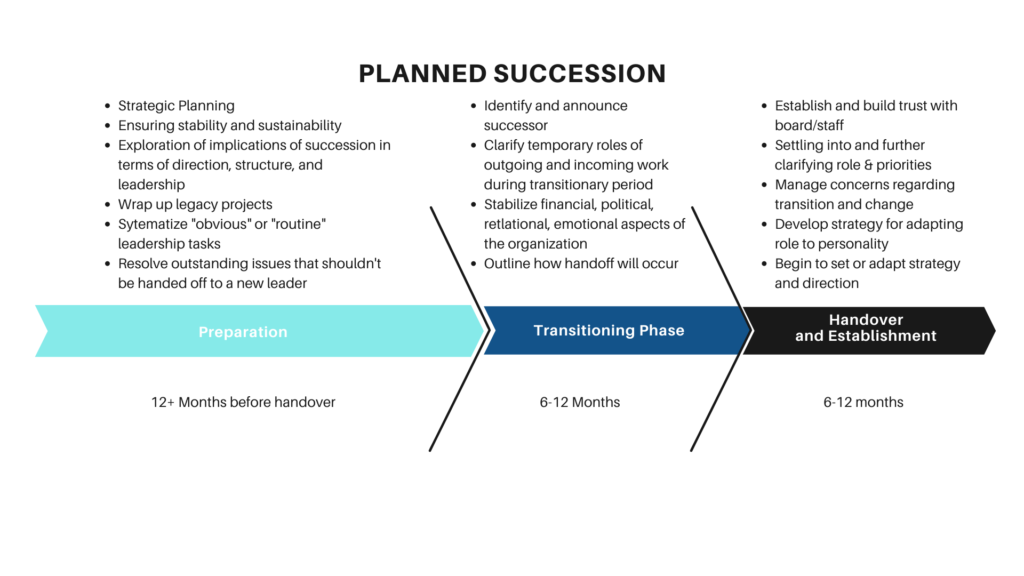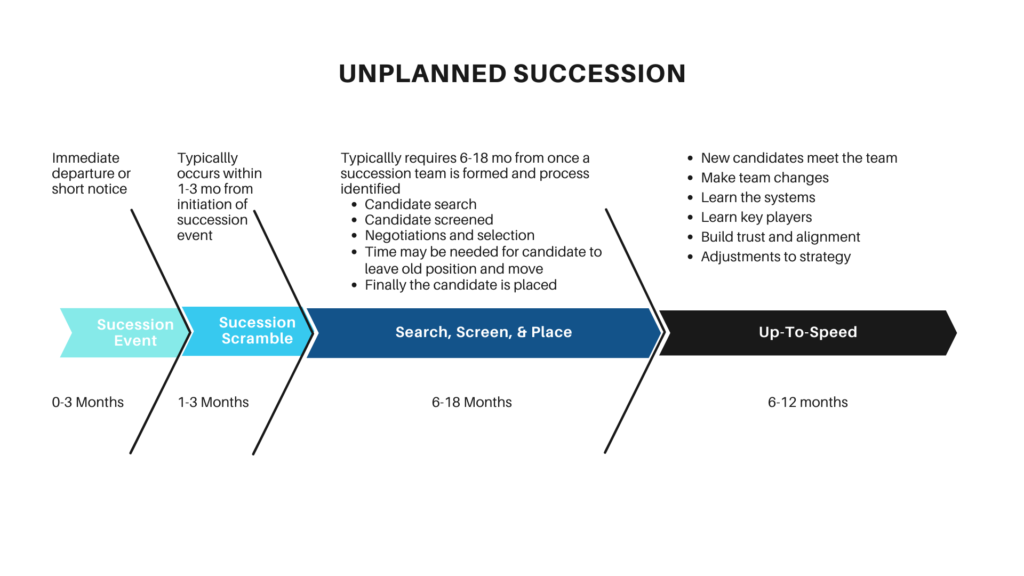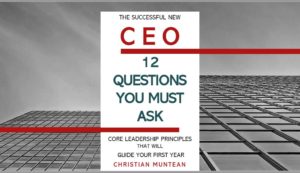Succession Strategy – Timing Is Everything


Summary: An illustration of the time required for leadership succession. Also, the key differences between how that time is spent in planned vs unplanned successions.
In life and work – some things have a low tolerance for lateness: Getting to the airport. Taking the roast out of the oven. The arrival of an ambulance. Paying your taxes.
You might catch another flight. The food might be edible. Someone might survive. The fee can be covered. But lateness tends to expand the problem. It is costly. It is disruptive.
Sure, organizations that don’t prepare for succession will probably survive. But it’ll be distracting. And stressful. The chances of choosing a successor who will underperform or fail increases. The likelihood of losing key staff goes up.
Not being prepared creates an unnecessary hassle and increases the burden on those who remain.
Being late with your succession plan = missing out on the opportunity to do it well.
Few leaders will dispute that succession planning has value. But they also agree that it will never feel urgent. Or particularly interesting.
That is until it is urgent. When an unplanned succession event[1] occurs it is suddenly an extremely fascinating topic.
No one has ever regretted that they took the time to plan for succession.
Succession planning takes time. The execution of that plan takes even more time. And it is time well invested.
As I’ve mentioned in a previous article, there are three different types of succession plans:
- Unplanned/Emergency Successions
- Executive Leadership Successions
- Key Staff Successions
Most organizations only think about executive succession planning after a succession event occurs.
Recently, in my community, there have been a number of widely known succession events. Many were early retirements. Some were unexpected deaths. A few were removals or encouraged “resignations”. In some, executives jumped to pursue a more attractive opportunity.
Unplanned successions have several tendencies: Their timing is inconvenient. Their notice is short. Or absent altogether. They often trigger a domino effect of a number of other leaders leaving soon after.
None of these events were described in the news or private conversations as “succession events”. That’s because the details of the departures were more interesting or dramatic or sad than everyone else’s work of moving on.
But regardless of why someone left, succession was what happened next. Precious few organizations were prepared for it.
Because unplanned successions tend to be short notice or immediate departures, not only would an executive succession plan be helpful – but an unplanned/emergency succession plan is needed. Unfortunately, that is usually lacking too.
Also, in most cases, partners or boards reached down to the next tier of leadership and appointed someone as interim leader. This leaves a gap in the organizational chart.
Suddenly staff succession planning would have been helpful.
A high number of successor leaders end up failing or quitting. For small and medium-sized organizations, every two out of three successors will fail. This usually doesn’t happen immediately. It usually takes one to three years for the board or partners to give up hope.
People rarely connect the dots between a lack of planning, reactive decision-making, and poor results. The failed successors will usually be blamed. Or extenuating circumstances. Not the leaders who should have thought about and prepared for this eventuality. But the responsibility lies squarely in their laps.
Both planned and unplanned successions take time.
Successions take time. But when that time is taken, the value of it is wildly different.
Here are two timelines that illustrate the differences. These timelines show what is typical. When there are exceptions to either – it is typically in terms of things taking longer than expected:
Main Take-away
Here’s the point with a nice bow on it: Your organization will spend a significant amount of time and energy on the topic of succession at some point. That is inevitable if it plans to continue operating.
What isn’t inevitable is when that time will be invested. Before a crisis or after?
Will it be invested strategically? Or reactively?
Will that investment more likely result in a higher functioning organization? Or is it more likely to result in ongoing instability?
The unexpected silver lining of planning: The work of succession planning builds better organizations.
The process of intentionally thinking through the questions associated with succession planning has an interesting byproduct: It makes the entire organization healthier and easier to manage.
Taking the time to think through topics like strategic direction, roles and responsibilities, stabilizing structures, wrapping up or discarding perpetually undone projects, etc – all lead to improved organizational performance and health.
How prepared are you for a succession event right now?
When is the right time for you to develop a succession strategy?
Take good care,
Christian
[1] A succession event is any event that triggers a leadership succession: Death, move, illness, termination, other opportunities, retirement, etc.
In the podcast Thought Leaders Driving Returns (TLDR), I’m interviewed by host Hunter Guthrie about how important mindset is in leadership and about effecting cultural change in the face of transition. LISTEN HERE.
Are you interested in learning more about becoming a successful CEO? If so, get a free copy of my book The Successful New CEO. Not a new CEO? I’ve been told by “old hands” that they felt any CEO should read this. So, click here to get your copy today.
by “old hands” that they felt any CEO should read this. So, click here to get your copy today.
Let’s connect.
I’m passionate about helping leaders to create workplaces they love going to and increasing the value of the services they offer. My results-oriented approach is tailored to each client’s specific situation and needs. As a leadership coach, I have developed a wealth of resources to help you and your team grow and become stronger.
Weekly Newsletter – sign up to receive my weekly articles addressing critical leadership challenges and issues.
The Leadership Coach Podcast – In my podcast, we explore effective, high-impact, and enjoyable leadership. Subscribe.
Resources – Visit my website’s Resources page for e-books, webinars, training, and leadership coaching opportunities for you and your team.
There are 𝟭𝟮 𝗰𝗿𝗶𝘁𝗶𝗰𝗮𝗹 𝗾𝘂𝗲𝘀𝘁𝗶𝗼𝗻𝘀 to ask before accepting a new CEO position. Do you know what they are? Instantly download my free e-book here.
Find the value of your company with my free assessment tool: The Value Builder System
The Value Builder System™ is a 13-minute online questionnaire that evaluates your business on the eight factors that contribute more to its attractiveness and value. These factors are scored on a scale of 1-100. Businesses that score over 80 are likely to command 70%-100% higher value than others.
Opportunities
Free Resource: How To Accomplish More Without Doing More is a workbook I created to walk leaders through a process of helping you own your calendar, liberate your time, and still get more done. Download it for free!
Executive and Leadership Coaching: Do you feel overwhelmed? Are you not getting the results you expect from the effort you are putting in? Do you find yourself facing similar challenges time and time again? Would you like to change specific ways of relating or reacting? If you would like to experience predictable, measurable growth Contact me.
Profitable Exit Strategy Workshop: Are you a business owner or partner? Over 55? Starting to think about exiting your business or active management in the next 3-5 years?
- Curious about what your business might be worth?
- Would you like to discover the specific steps you need to take to increase its value and become highly attractive to a buyer?
- Are you planning on handing it over to family or employees and you want to ensure long-term success?
If so, contact me now
Categories
Get Christian’s Newest Book: Train to Lead

Download my free 10-page eBook:
How To Accomplish More Without Doing More:
Eight Proven Strategies To Change Your Life
Discover how to save eight hours during your workweek-even if you're too busy to even think about it. The resource every maxed out executive needs.



